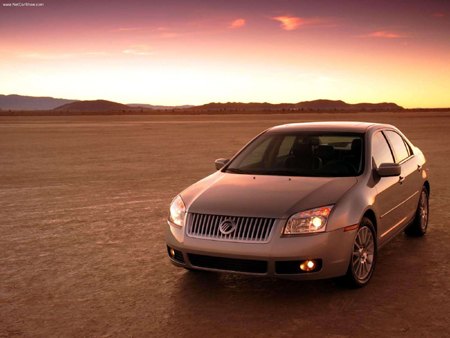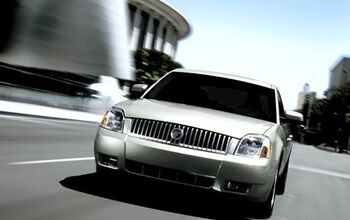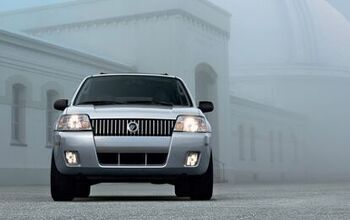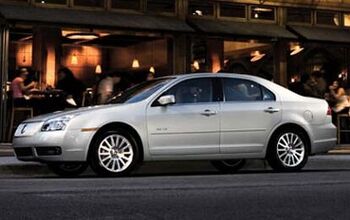Mercury Milan Review
Milan is the fashion capital of Italy. Step off the tourist trail and it’s a combination of industrial parks and urban sprawl with only slightly more charm than Trenton, New Jersey. Still, you have got to give Ford’s beleaguered near-luxury division credit for naming their hecho-en-Mexico Fusion derivative after the home of Alfa Romeo, rather than resorting to the alphanumerics afflicting Lincoln’s take on the same model. But the question remains: is Mercury’s glammed-up Fusion a credible fashionista or an industrial waste?
The Milan's grill is the most striking difference between Mercury’s mid-market sedan and the car upon which it's based. While Ford decorated their front wheel-driver’s front room with Venetian blinds, Mercury opted for verticals. Less obviously, the Milan’s lower front fascia is more pronounced, the bright work less blingy, the wheels statelier and the rear lights look less… like an aftermarket afterthought.
Subtle as they are, the changes work. The Milan projects greater maturity and wealth than its FoMoCo donormobile. And compared to the redesigned Toyota Camry, whose front-end looks like a saggy-nosed boxer after years of cartilage pulverizing abuse, the Milan is elegantly beautiful.
Color has a Jekyll and Hyde effect on Milan’s mien. The more vibrant hues– Redfire Red, Ebony Black and Dark Blue Pearl– establish a welcome contrast to the crystalline headlight cluster and chrome accents, projecting the requisite eau de upmarket. Conversely, the bland non-color tones– Charcoal Beige, Dune Pearl, Light Tundra, Satellite Silver, Silver Frost or Tungsten Silver— create a pale and pasty pallet of pernicious pabulum.
The Milan’s interior is proof positive that Ford knows how to design and assemble a comfortable, graceful and ergonomic interior. OK, the panel gaps around the dash top cubby can be seen from outer space. And most of the luxury stuff that should be basic– automatic climate control, heated seats, leather wrapped steering wheel with secondary controls, etc.– is optional (bumping the Milan's price towards the Lincoln Fusion homonym). But there are some genuinely nice touches.
For example, the Milan’s center-mounted analog clock is so-not-plastic and the wood is. And kudos to Ford Mercury for the clever center storage bin that combines an MP3 jack, Nintendo-friendly power point and change holder.
The Milan’s elegant monochromatic gauges could use a touch of red, as in REDLINE. While it’s not a concern when driving a Milan equipped with a five-speed automatic, pistonheads opting for stick shift (available on the four cylinder engine) must rely on their ears to avoid triggering the engine’s self-preservation software.
As with the Fusion, the Milan comes in a choice of a 2.3-liter in-line four or a 3.0-liter Duratec V6. The four-cylinder mill produces a class appropriate power (160hp @ 6250rpm) and economy (23/31mpg). It revs effortlessly and remains suitably hushed at cruising speed.
Unfortunately, the manual transmission’s 3.31:1 first gear ratio is a little too much for an engine whose 150ft.-lbs. peak torque doesn’t arrive until 4250rpm. (Translation: unless you rev the engine and dump the clutch north of 3000rpm, you ain't going nowhere fast.)
The V6 Milan delivers an altogether different driving experience. Mated to a six-speed slushbox, the silken six-cylinder engine puts Toyota’s, Nissan’s and Honda’s mills to shame, redefining smooth, effortless, frugal and dependable power for the entire mid-size market.
Just kidding.
Don’t get me wrong: the Duratec is a fine engine. But discriminating buyers will notice that the Milan’s 221hp six banger quickly runs out of puff, especially compared to Honda Accord (244hp) Toyota Camry (268hp) and Nissan Altima (270hp). The Milan's mill is also a pretty thrashy unit, with a decidedly downmarket sonic signature.
While the Milan’s mechanical anemia should eliminate torque steer, it doesn’t. Under hard acceleration, the sedan's front end rises like a powerboat as the forward donuts scrabble for purchase. For less adrenal (read: older) buyers, it’s no biggie. These comfort-oriented customers will be well satisfied with the Milan’s sophisticated short and long arm (SLA) front and multi-link rear suspenders. So equipped, the magic carpet Milan surmounts highway irregularities with near-Camry refinement.
On the fun-to-drive side of things, the Milan carves corners with Accordian poise and precision. I'm not saying the mid-sized Merc begs to be whipped. But when your inner hooligan tempts your soul, the Milan has enough spring in its step to keep everyone heading in the right direction.
At the end of my test drive, I asked my handler why anyone would buy a Mercury Milan over a Ford Fusion. “Why eat with a plastic fork when you can dine with a silver spoon?” I reckon that depends on what and where you’re eating. And even if we accept the analogy, the Milan is, at best, a silver plated plastic fork.
Anyway, the bottom line: for around $600 over the Fusion SE, you can buy a few optional trim choices and a slightly nicer looking ride. And that’s about it. I don't know about you, but that doesn’t sound very glamorous to me.
More by William C Montgomery
Latest Car Reviews
Read moreLatest Product Reviews
Read moreRecent Comments
- Lichtronamo Watch as the non-us based automakers shift more production to Mexico in the future.
- 28-Cars-Later " Electrek recently dug around in Tesla’s online parts catalog and found that the windshield costs a whopping $1,900 to replace.To be fair, that’s around what a Mercedes S-Class or Rivian windshield costs, but the Tesla’s glass is unique because of its shape. It’s also worth noting that most insurance plans have glass replacement options that can make the repair a low- or zero-cost issue. "Now I understand why my insurance is so high despite no claims for years and about 7,500 annual miles between three cars.
- AMcA My theory is that that when the Big 3 gave away the store to the UAW in the last contract, there was a side deal in which the UAW promised to go after the non-organized transplant plants. Even the UAW understands that if the wage differential gets too high it's gonna kill the golden goose.
- MKizzy Why else does range matter? Because in the EV advocate's dream scenario of a post-ICE future, the average multi-car household will find itself with more EVs in their garages and driveways than places to plug them in or the capacity to charge then all at once without significant electrical upgrades. Unless each vehicle has enough range to allow for multiple days without plugging in, fighting over charging access in multi-EV households will be right up there with finances for causes of domestic strife.
- 28-Cars-Later WSJ blurb in Think or Swim:Workers at Volkswagen's Tennessee factory voted to join the United Auto Workers, marking a historic win for the 89- year-old union that is seeking to expand where it has struggled before, with foreign-owned factories in the South.The vote is a breakthrough for the UAW, whose membership has shrunk by about three-quarters since the 1970s, to less than 400,000 workers last year.UAW leaders have hitched their growth ambitions to organizing nonunion auto factories, many of which are in southern states where the Detroit-based labor group has failed several times and antiunion sentiment abounds."People are ready for change," said Kelcey Smith, 48, who has worked in the VW plant's paint shop for about a year, after leaving his job at an Amazon.com warehouse in town. "We look forward to making history and bringing change throughout the entire South." ...Start the clock on a Chattanooga shutdown.





































Comments
Join the conversation
We didn't want to steal your thunder!
"I don’t understand Ford brand management. The Mercury brand should have options only specific to Mercury like a engine or drive train not chrome and plastic bits. Mercury is supposed to be their upmarket brand correct? " Huh? Mercedes, BMW, Toyota and VW share engine options among an array of models and brands. The Fusion and Milan clearly share many components and interior pieces, but there are significant sheetmetal differences and features (like LED tail-lamps) that make the Milan appropriately upmarket compared to the Fusion. I think it's a sharp looking ride, whereas I'm not impressed with the yawn styling of the Fusion.